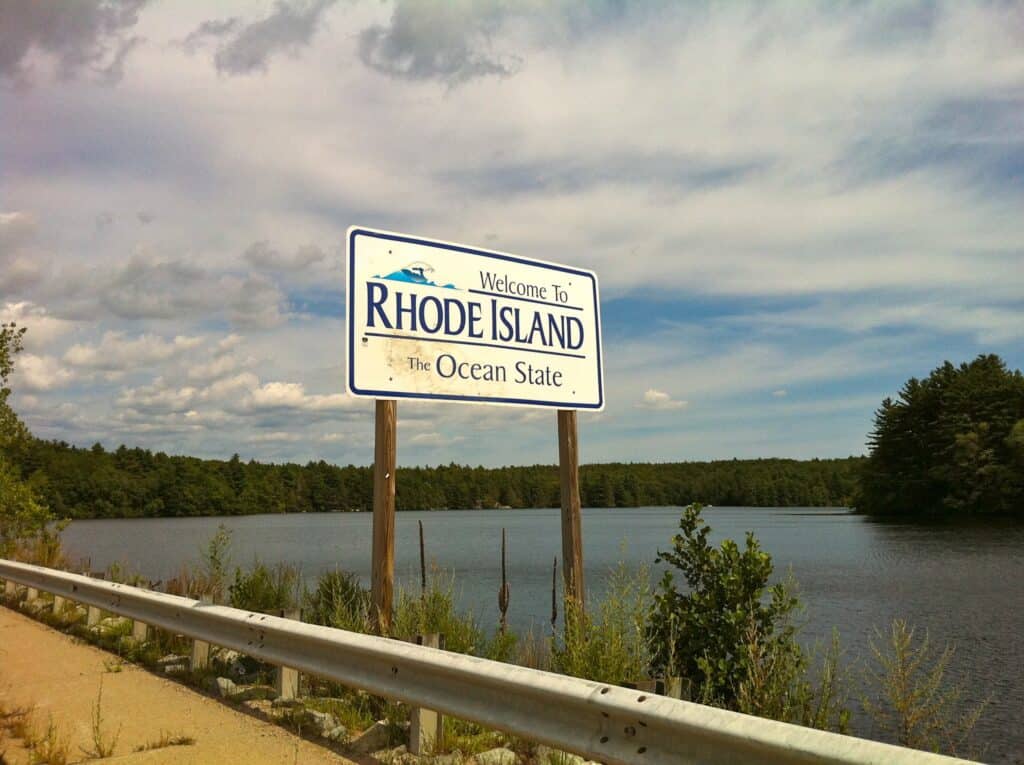Scituate Reservoir is the largest man-made lake in Rhode Island. Located in the center of the state near the city of Scituate, the 5.3 square mile reservoir supplies 60 percent of the drinking water to the state. This includes the capital city Providence. Created by building an earth-filled dam, now known as the Gainer Memorial Dam, the reservoir sits across the North Branch Pawtuxet River.
The Moswansicut River and Ponaganset River drain into the reservoir. They are part of a drainage basin of nearly 94 square miles.
Scituate Reservoir History

The Scituate Reservoir is Rhode Island’s biggest man-made lake.
©JohnMernick/Shutterstock.com
Before the Reservoir
In the early years, the primary source of water for residents of the state and the city of Providence was wells. In 1853, the state identified the city’s need for a public water supply. in 1869, after much debate and four rounds of public voting, the Pawtuxet River started supplying water to Providence. On December 1, 1871, the first service from the river began.
In 1906, water purification systems were installed, and the reservoir served the cities of Providence, Cranston, Warwick, Johnston, and North Providence. During arid weather, water consumption would exceed the river’s natural flow. Upstream mills released water stored in their small reservoirs to compensate for the shortage.
Unfortunately, the water quality from the river was also declining due to residential and industrial pollution leaking into the groundwater. In 1913, the constant threat of a water shortage and pollution prompted the city council to form a committee. They eventually passed legislation to investigate water supply and built new modern systems.
Planning the Reservoir
Starting in 1913, new secret reservoir plans and discussions emerged. If approved, these plans would flood several towns in the rural area. Beginning in 1916, nearly 1600 residents of Rockland, Kent, Ashland, Wilbur Hollow, Richmond, South Scituate, Saundersville, Ponaganset, North Scituate, and Clayville were notified that they would have to move due to flood warnings.
While these residents would receive compensation, many were angry and had lived in the area for 200 years. Some residents even committed suicide. From 1916 to 1930, the area’s population decreased by 24 percent.
Building the Gainer Memorial Dam
Construction of the Gainer Memorial Dam began soon after 1916. At that time in the state, It was the largest construction project ever. The dam currently stands at about 3,200 feet wide and 100 feet deep. It holds about 56 billion gallons of water and, at the time, cost around $20 million to build (nearly $300 million today). The reservoir began filling on November 10, 1925 and took nearly one year to complete.
The dam project destroyed 1,195 buildings. These included 375 homes, 233 barns, seven schools, six churches, 30 dairy barns, six mills, post offices, stores, and taverns. In addition to the lost property, nearly 5,000 bodies were removed from cemeteries and relocated.
The Largest Man-Made Lake in Rhode Island Today

The Scituate Reservoir system is Rhode Island’s largest inland body of water.
©Morrow Long / flickr – License
An aqueduct transferred water from the reservoir to a nearby treatment plant. The original treatment plant was technologically superior to any other plant in New England and began operation on September 30, 1926. Upgraded in the 1940s and 1960s, the plant has since been renovated. It remains the most significant water treatment plant in New England. It has a treatment capacity of 144 million gallons per day.
Once water leaves the plant, it travels through another aqueduct to feed the city’s water system. The original aqueduct was 90 inches in diameter and 4.5 miles long. Today, 3.3 miles of the aqueduct is a tunnel that delivers water to a building called a siphon chamber in Cranston, RI. This building splits into a series of smaller pipes that supply the water distribution system. In the 1970s, a second aqueduct from the treatment plant was built, which was 78 inches and 102 inches in diameter and 9.5 miles long. It transferred water to another facility in Cranston. Both aqueducts are strictly gravity flow, with no pumping needed.
Preventing pollution of the reservoir is a significant concern. The state owns nearly all of the land around the reservoir and does not allow any development. After the reservoir was completed, nearly seven million trees were planted in the watershed basin. The trees prevent erosion and help to “filter” the water flowing into the reservoir. In the 1980s, plans to build I-84 from Connecticut to Providence were scrapped over fears that the interstate was too close to the reservoir. Recreation on the reservoir is prohibited due to fears of threatening the water supply. However, nature lovers can still enjoy the views.
Where Is Scituate Reservoir Located on a Map?
The Scituate Reservoir is located in Providence County, around a 14-mile drive from East Providence. Its watershed mainly covers the rural towns of Scituate, Foster, and Glocester, as well as sections of western Cranston and Johnston. It is just over an hour’s drive from Boston, Massachusetts.
The photo featured at the top of this post is © JohnMernick/Shutterstock.com
Sources
- Wikipedia, Available here: https://en.wikipedia.org/wiki/Scituate_Reservoir
- WPWA, Available here: https://www.wpwa.org/documents/education/Bamberg_Scituate%20Reservoir.pdf
- Land Water Connection, Available here: https://www.nricd.org/landwaterconnection/providence-water-history.html
Thank you for reading! Have some feedback for us? Contact the AZ Animals editorial team.






